Cyber Security: Analyzing Modern Corporate Challenges and Solutions
VerifiedAdded on 2019/11/29
|15
|3285
|40
Report
AI Summary
This report delves into the escalating cyber security challenges confronting modern corporations. It examines the growing use of the internet and its impact on businesses, highlighting the increasing risks associated with cybercrimes such as malware, hacking, and insider threats. The report analyzes various threats, including ransomware, Distributed Denial of Service (DDoS) attacks, hacktivism, the Internet of Things vulnerabilities, insider threats, mobile malware, machine learning risks, and fake advertisements. It emphasizes the need for robust security measures, including physical security, data encryption, and employee training. Furthermore, it provides recommendations for improving cyber security functions within enterprises, offering valuable insights into protecting sensitive data and mitigating potential cyber-attacks. The report underscores the importance of proactive measures to safeguard against the ever-evolving cyber threat landscape, ensuring business continuity and data integrity.
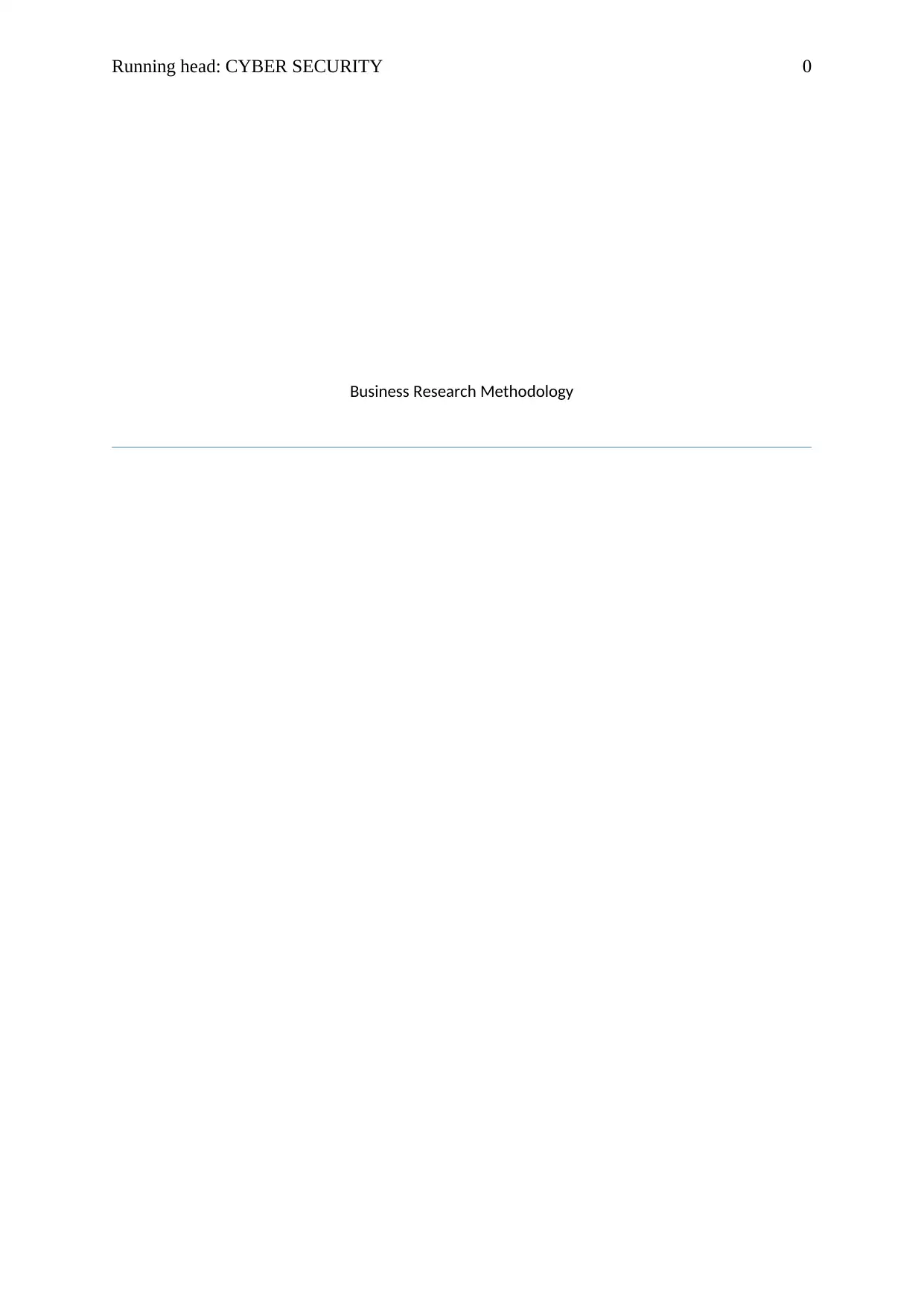
Running head: CYBER SECURITY 0
Business Research Methodology
Business Research Methodology
Paraphrase This Document
Need a fresh take? Get an instant paraphrase of this document with our AI Paraphraser
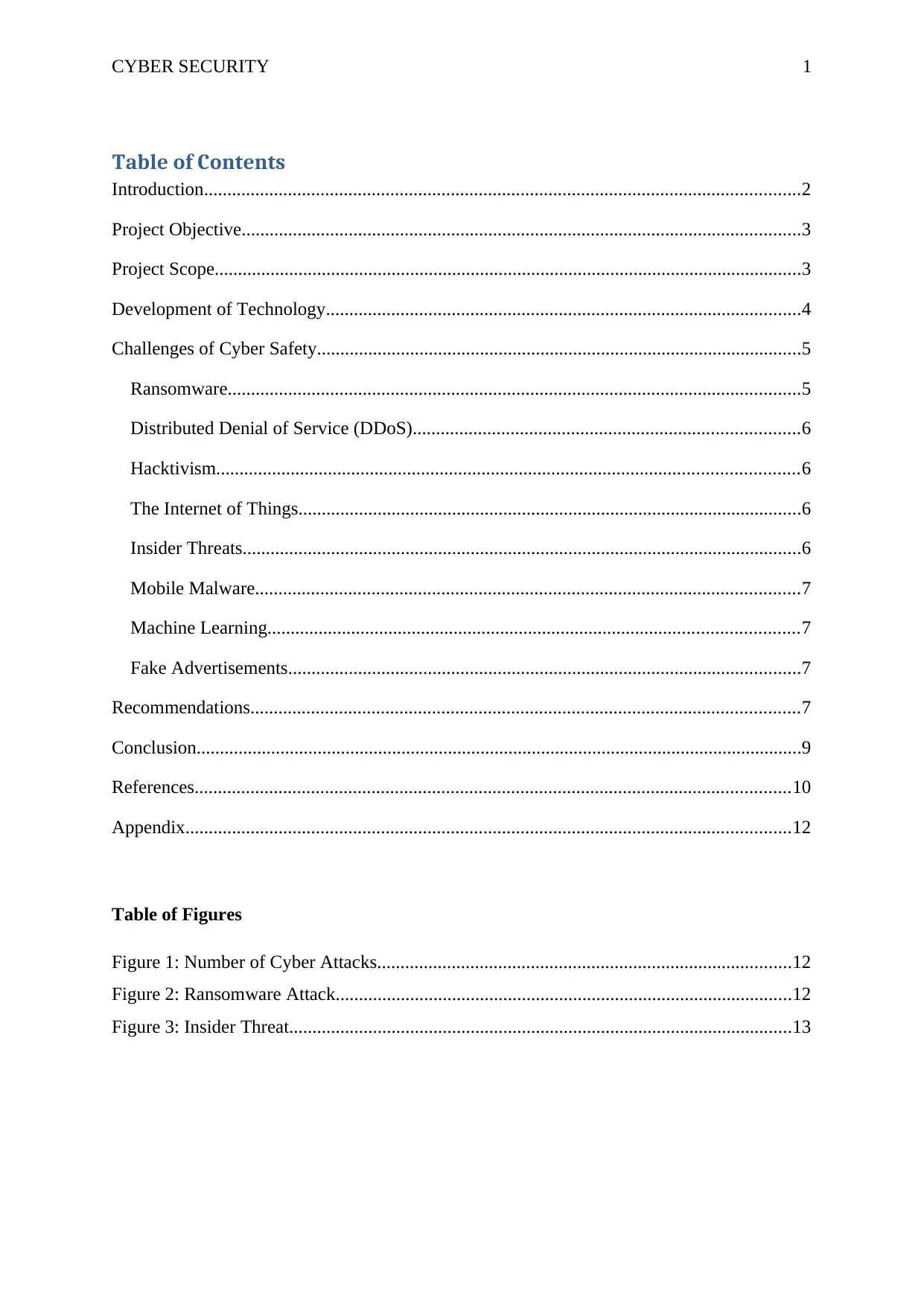
CYBER SECURITY 1
Table of Contents
Introduction................................................................................................................................2
Project Objective........................................................................................................................3
Project Scope..............................................................................................................................3
Development of Technology......................................................................................................4
Challenges of Cyber Safety........................................................................................................5
Ransomware...........................................................................................................................5
Distributed Denial of Service (DDoS)...................................................................................6
Hacktivism.............................................................................................................................6
The Internet of Things............................................................................................................6
Insider Threats........................................................................................................................6
Mobile Malware.....................................................................................................................7
Machine Learning..................................................................................................................7
Fake Advertisements..............................................................................................................7
Recommendations......................................................................................................................7
Conclusion..................................................................................................................................9
References................................................................................................................................10
Appendix..................................................................................................................................12
Table of Figures
Figure 1: Number of Cyber Attacks.........................................................................................12
Figure 2: Ransomware Attack..................................................................................................12
Figure 3: Insider Threat............................................................................................................13
Table of Contents
Introduction................................................................................................................................2
Project Objective........................................................................................................................3
Project Scope..............................................................................................................................3
Development of Technology......................................................................................................4
Challenges of Cyber Safety........................................................................................................5
Ransomware...........................................................................................................................5
Distributed Denial of Service (DDoS)...................................................................................6
Hacktivism.............................................................................................................................6
The Internet of Things............................................................................................................6
Insider Threats........................................................................................................................6
Mobile Malware.....................................................................................................................7
Machine Learning..................................................................................................................7
Fake Advertisements..............................................................................................................7
Recommendations......................................................................................................................7
Conclusion..................................................................................................................................9
References................................................................................................................................10
Appendix..................................................................................................................................12
Table of Figures
Figure 1: Number of Cyber Attacks.........................................................................................12
Figure 2: Ransomware Attack..................................................................................................12
Figure 3: Insider Threat............................................................................................................13
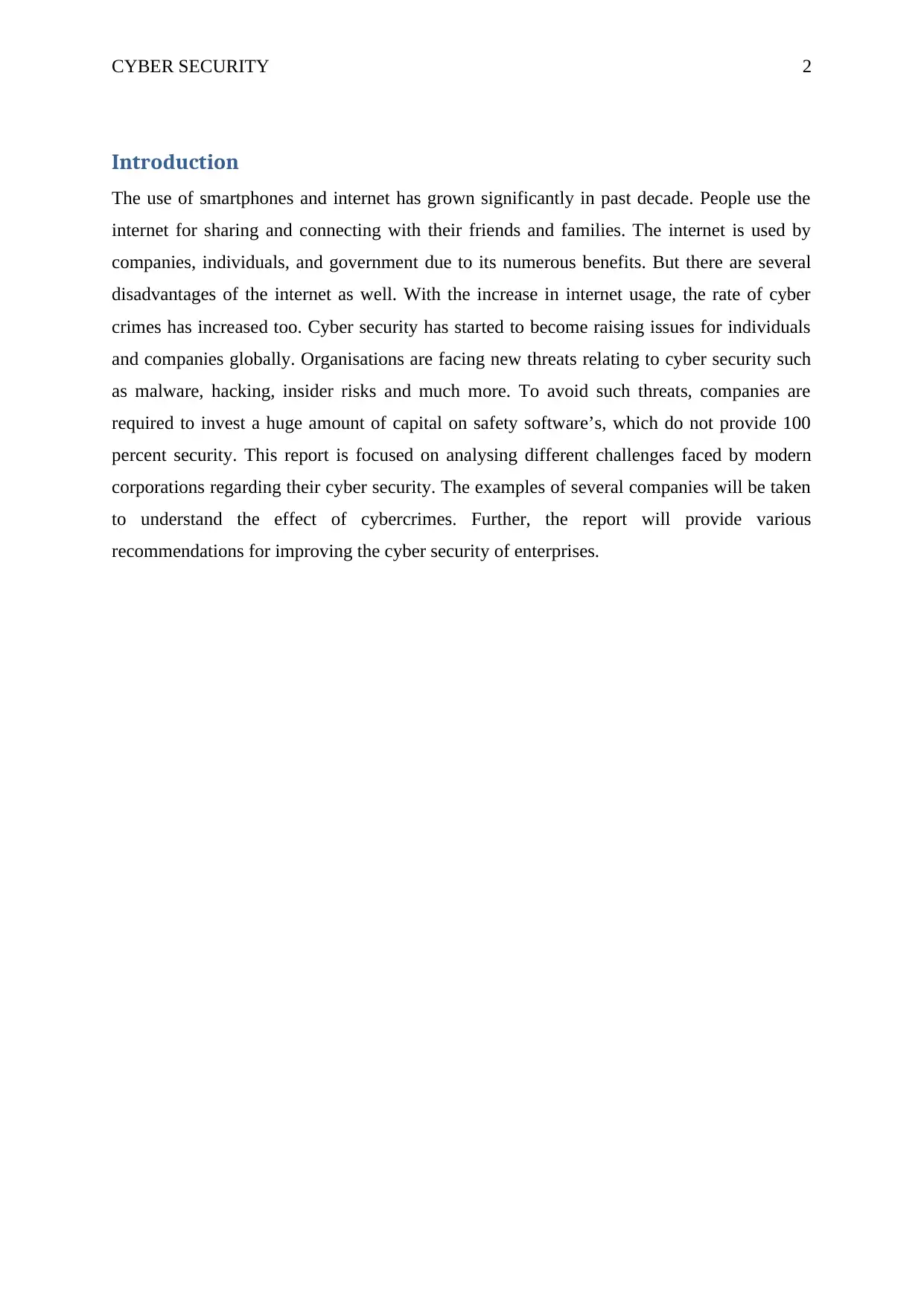
CYBER SECURITY 2
Introduction
The use of smartphones and internet has grown significantly in past decade. People use the
internet for sharing and connecting with their friends and families. The internet is used by
companies, individuals, and government due to its numerous benefits. But there are several
disadvantages of the internet as well. With the increase in internet usage, the rate of cyber
crimes has increased too. Cyber security has started to become raising issues for individuals
and companies globally. Organisations are facing new threats relating to cyber security such
as malware, hacking, insider risks and much more. To avoid such threats, companies are
required to invest a huge amount of capital on safety software’s, which do not provide 100
percent security. This report is focused on analysing different challenges faced by modern
corporations regarding their cyber security. The examples of several companies will be taken
to understand the effect of cybercrimes. Further, the report will provide various
recommendations for improving the cyber security of enterprises.
Introduction
The use of smartphones and internet has grown significantly in past decade. People use the
internet for sharing and connecting with their friends and families. The internet is used by
companies, individuals, and government due to its numerous benefits. But there are several
disadvantages of the internet as well. With the increase in internet usage, the rate of cyber
crimes has increased too. Cyber security has started to become raising issues for individuals
and companies globally. Organisations are facing new threats relating to cyber security such
as malware, hacking, insider risks and much more. To avoid such threats, companies are
required to invest a huge amount of capital on safety software’s, which do not provide 100
percent security. This report is focused on analysing different challenges faced by modern
corporations regarding their cyber security. The examples of several companies will be taken
to understand the effect of cybercrimes. Further, the report will provide various
recommendations for improving the cyber security of enterprises.
⊘ This is a preview!⊘
Do you want full access?
Subscribe today to unlock all pages.

Trusted by 1+ million students worldwide
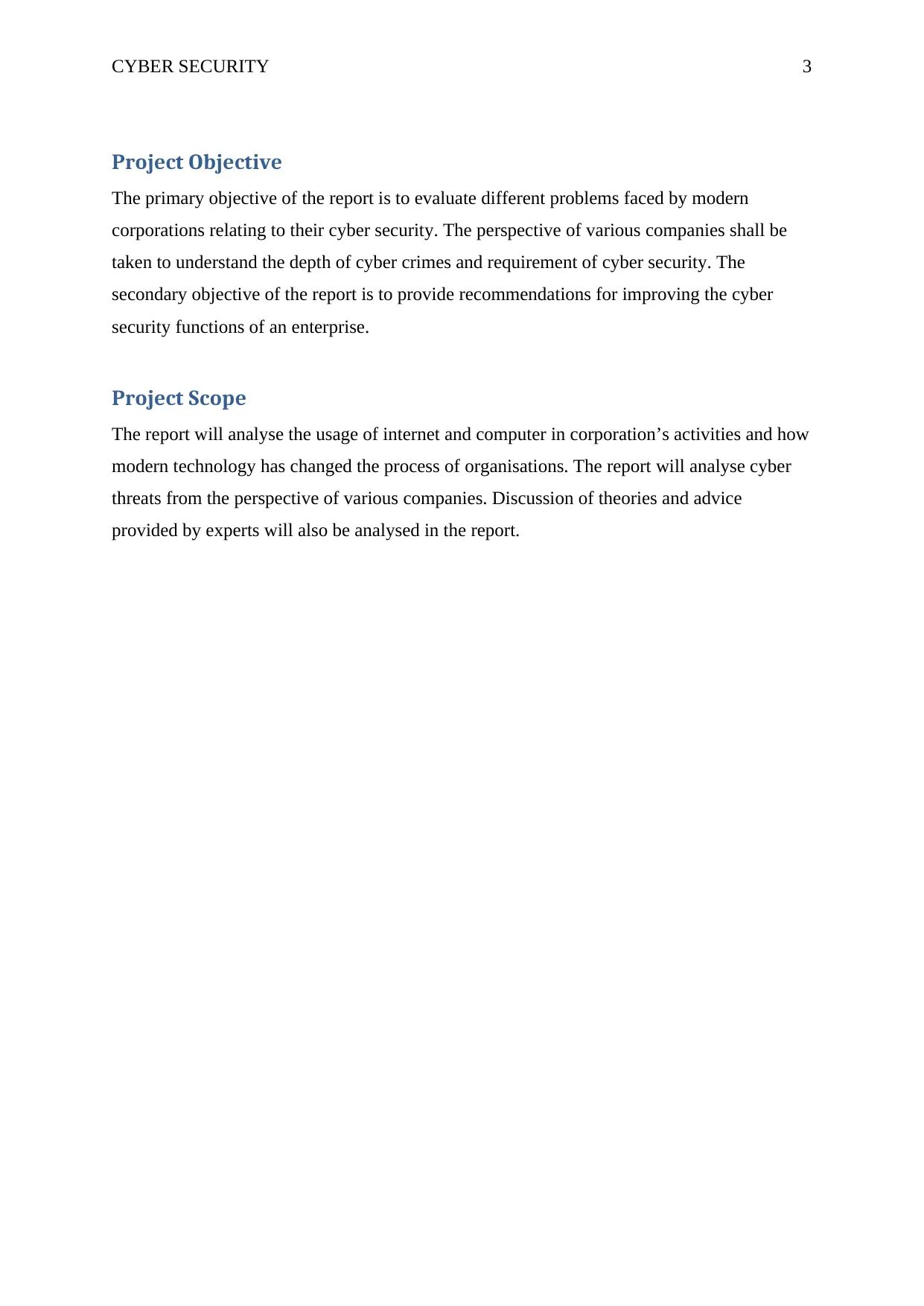
CYBER SECURITY 3
Project Objective
The primary objective of the report is to evaluate different problems faced by modern
corporations relating to their cyber security. The perspective of various companies shall be
taken to understand the depth of cyber crimes and requirement of cyber security. The
secondary objective of the report is to provide recommendations for improving the cyber
security functions of an enterprise.
Project Scope
The report will analyse the usage of internet and computer in corporation’s activities and how
modern technology has changed the process of organisations. The report will analyse cyber
threats from the perspective of various companies. Discussion of theories and advice
provided by experts will also be analysed in the report.
Project Objective
The primary objective of the report is to evaluate different problems faced by modern
corporations relating to their cyber security. The perspective of various companies shall be
taken to understand the depth of cyber crimes and requirement of cyber security. The
secondary objective of the report is to provide recommendations for improving the cyber
security functions of an enterprise.
Project Scope
The report will analyse the usage of internet and computer in corporation’s activities and how
modern technology has changed the process of organisations. The report will analyse cyber
threats from the perspective of various companies. Discussion of theories and advice
provided by experts will also be analysed in the report.
Paraphrase This Document
Need a fresh take? Get an instant paraphrase of this document with our AI Paraphraser
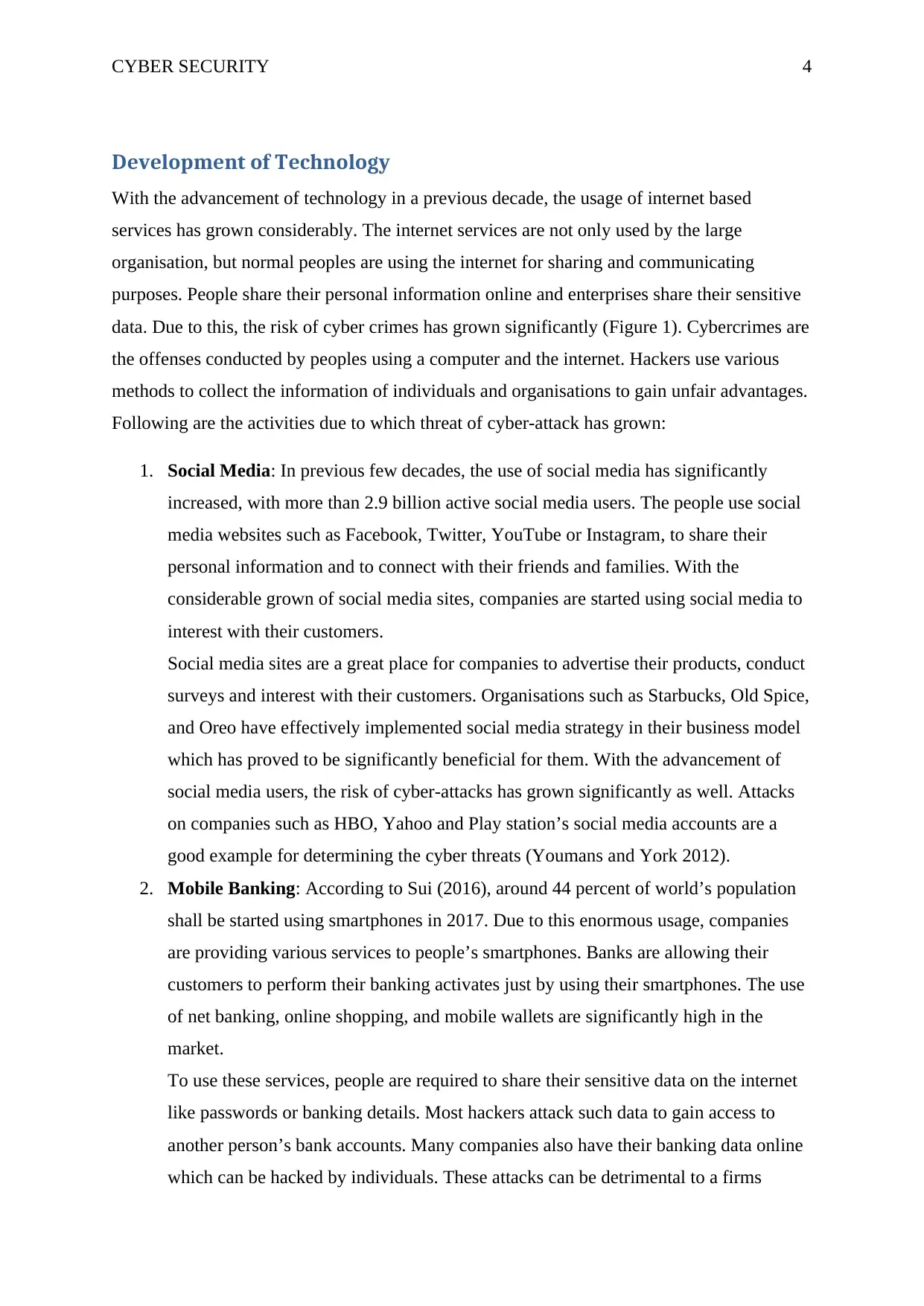
CYBER SECURITY 4
Development of Technology
With the advancement of technology in a previous decade, the usage of internet based
services has grown considerably. The internet services are not only used by the large
organisation, but normal peoples are using the internet for sharing and communicating
purposes. People share their personal information online and enterprises share their sensitive
data. Due to this, the risk of cyber crimes has grown significantly (Figure 1). Cybercrimes are
the offenses conducted by peoples using a computer and the internet. Hackers use various
methods to collect the information of individuals and organisations to gain unfair advantages.
Following are the activities due to which threat of cyber-attack has grown:
1. Social Media: In previous few decades, the use of social media has significantly
increased, with more than 2.9 billion active social media users. The people use social
media websites such as Facebook, Twitter, YouTube or Instagram, to share their
personal information and to connect with their friends and families. With the
considerable grown of social media sites, companies are started using social media to
interest with their customers.
Social media sites are a great place for companies to advertise their products, conduct
surveys and interest with their customers. Organisations such as Starbucks, Old Spice,
and Oreo have effectively implemented social media strategy in their business model
which has proved to be significantly beneficial for them. With the advancement of
social media users, the risk of cyber-attacks has grown significantly as well. Attacks
on companies such as HBO, Yahoo and Play station’s social media accounts are a
good example for determining the cyber threats (Youmans and York 2012).
2. Mobile Banking: According to Sui (2016), around 44 percent of world’s population
shall be started using smartphones in 2017. Due to this enormous usage, companies
are providing various services to people’s smartphones. Banks are allowing their
customers to perform their banking activates just by using their smartphones. The use
of net banking, online shopping, and mobile wallets are significantly high in the
market.
To use these services, people are required to share their sensitive data on the internet
like passwords or banking details. Most hackers attack such data to gain access to
another person’s bank accounts. Many companies also have their banking data online
which can be hacked by individuals. These attacks can be detrimental to a firms
Development of Technology
With the advancement of technology in a previous decade, the usage of internet based
services has grown considerably. The internet services are not only used by the large
organisation, but normal peoples are using the internet for sharing and communicating
purposes. People share their personal information online and enterprises share their sensitive
data. Due to this, the risk of cyber crimes has grown significantly (Figure 1). Cybercrimes are
the offenses conducted by peoples using a computer and the internet. Hackers use various
methods to collect the information of individuals and organisations to gain unfair advantages.
Following are the activities due to which threat of cyber-attack has grown:
1. Social Media: In previous few decades, the use of social media has significantly
increased, with more than 2.9 billion active social media users. The people use social
media websites such as Facebook, Twitter, YouTube or Instagram, to share their
personal information and to connect with their friends and families. With the
considerable grown of social media sites, companies are started using social media to
interest with their customers.
Social media sites are a great place for companies to advertise their products, conduct
surveys and interest with their customers. Organisations such as Starbucks, Old Spice,
and Oreo have effectively implemented social media strategy in their business model
which has proved to be significantly beneficial for them. With the advancement of
social media users, the risk of cyber-attacks has grown significantly as well. Attacks
on companies such as HBO, Yahoo and Play station’s social media accounts are a
good example for determining the cyber threats (Youmans and York 2012).
2. Mobile Banking: According to Sui (2016), around 44 percent of world’s population
shall be started using smartphones in 2017. Due to this enormous usage, companies
are providing various services to people’s smartphones. Banks are allowing their
customers to perform their banking activates just by using their smartphones. The use
of net banking, online shopping, and mobile wallets are significantly high in the
market.
To use these services, people are required to share their sensitive data on the internet
like passwords or banking details. Most hackers attack such data to gain access to
another person’s bank accounts. Many companies also have their banking data online
which can be hacked by individuals. These attacks can be detrimental to a firms
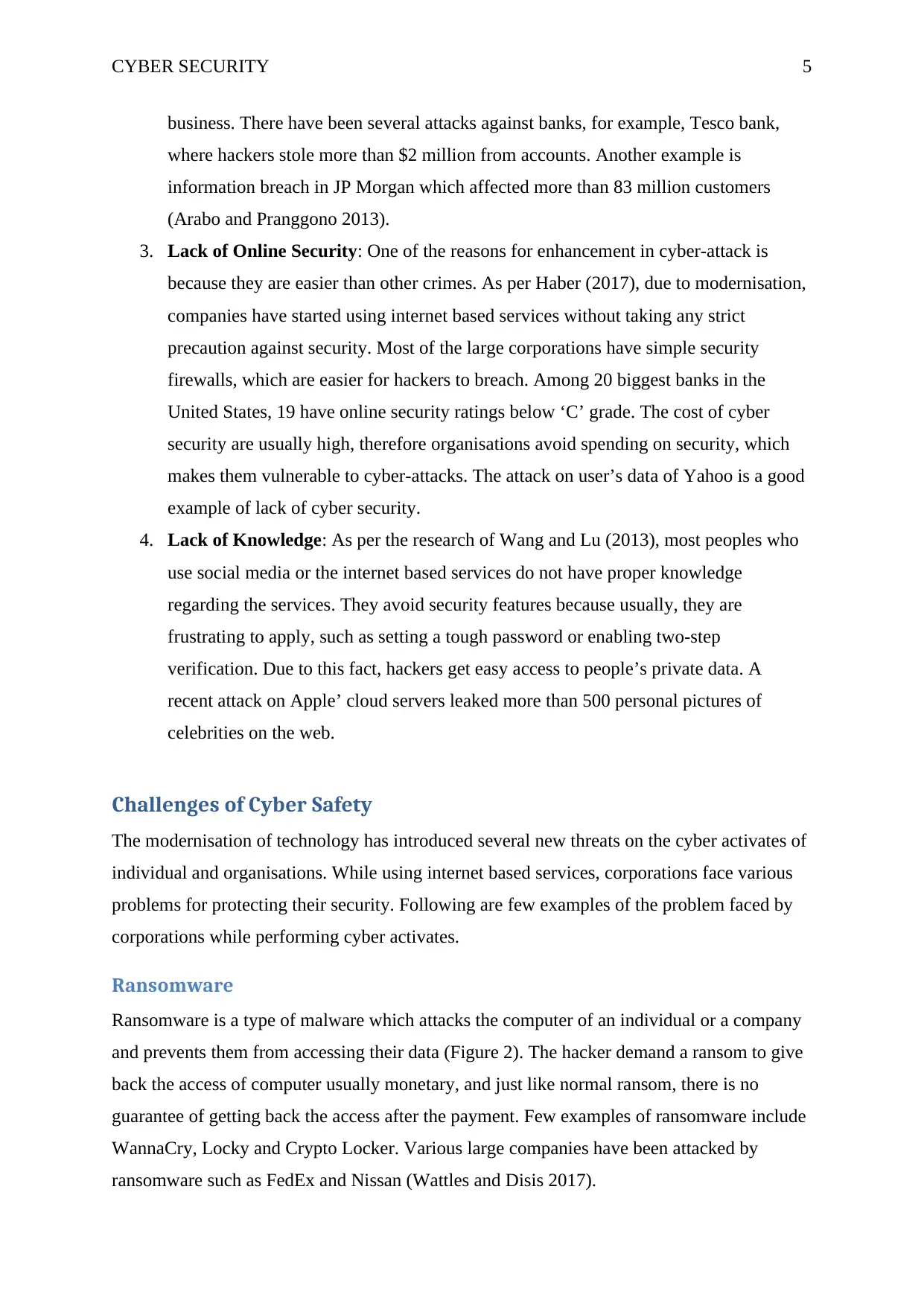
CYBER SECURITY 5
business. There have been several attacks against banks, for example, Tesco bank,
where hackers stole more than $2 million from accounts. Another example is
information breach in JP Morgan which affected more than 83 million customers
(Arabo and Pranggono 2013).
3. Lack of Online Security: One of the reasons for enhancement in cyber-attack is
because they are easier than other crimes. As per Haber (2017), due to modernisation,
companies have started using internet based services without taking any strict
precaution against security. Most of the large corporations have simple security
firewalls, which are easier for hackers to breach. Among 20 biggest banks in the
United States, 19 have online security ratings below ‘C’ grade. The cost of cyber
security are usually high, therefore organisations avoid spending on security, which
makes them vulnerable to cyber-attacks. The attack on user’s data of Yahoo is a good
example of lack of cyber security.
4. Lack of Knowledge: As per the research of Wang and Lu (2013), most peoples who
use social media or the internet based services do not have proper knowledge
regarding the services. They avoid security features because usually, they are
frustrating to apply, such as setting a tough password or enabling two-step
verification. Due to this fact, hackers get easy access to people’s private data. A
recent attack on Apple’ cloud servers leaked more than 500 personal pictures of
celebrities on the web.
Challenges of Cyber Safety
The modernisation of technology has introduced several new threats on the cyber activates of
individual and organisations. While using internet based services, corporations face various
problems for protecting their security. Following are few examples of the problem faced by
corporations while performing cyber activates.
Ransomware
Ransomware is a type of malware which attacks the computer of an individual or a company
and prevents them from accessing their data (Figure 2). The hacker demand a ransom to give
back the access of computer usually monetary, and just like normal ransom, there is no
guarantee of getting back the access after the payment. Few examples of ransomware include
WannaCry, Locky and Crypto Locker. Various large companies have been attacked by
ransomware such as FedEx and Nissan (Wattles and Disis 2017).
business. There have been several attacks against banks, for example, Tesco bank,
where hackers stole more than $2 million from accounts. Another example is
information breach in JP Morgan which affected more than 83 million customers
(Arabo and Pranggono 2013).
3. Lack of Online Security: One of the reasons for enhancement in cyber-attack is
because they are easier than other crimes. As per Haber (2017), due to modernisation,
companies have started using internet based services without taking any strict
precaution against security. Most of the large corporations have simple security
firewalls, which are easier for hackers to breach. Among 20 biggest banks in the
United States, 19 have online security ratings below ‘C’ grade. The cost of cyber
security are usually high, therefore organisations avoid spending on security, which
makes them vulnerable to cyber-attacks. The attack on user’s data of Yahoo is a good
example of lack of cyber security.
4. Lack of Knowledge: As per the research of Wang and Lu (2013), most peoples who
use social media or the internet based services do not have proper knowledge
regarding the services. They avoid security features because usually, they are
frustrating to apply, such as setting a tough password or enabling two-step
verification. Due to this fact, hackers get easy access to people’s private data. A
recent attack on Apple’ cloud servers leaked more than 500 personal pictures of
celebrities on the web.
Challenges of Cyber Safety
The modernisation of technology has introduced several new threats on the cyber activates of
individual and organisations. While using internet based services, corporations face various
problems for protecting their security. Following are few examples of the problem faced by
corporations while performing cyber activates.
Ransomware
Ransomware is a type of malware which attacks the computer of an individual or a company
and prevents them from accessing their data (Figure 2). The hacker demand a ransom to give
back the access of computer usually monetary, and just like normal ransom, there is no
guarantee of getting back the access after the payment. Few examples of ransomware include
WannaCry, Locky and Crypto Locker. Various large companies have been attacked by
ransomware such as FedEx and Nissan (Wattles and Disis 2017).
⊘ This is a preview!⊘
Do you want full access?
Subscribe today to unlock all pages.

Trusted by 1+ million students worldwide
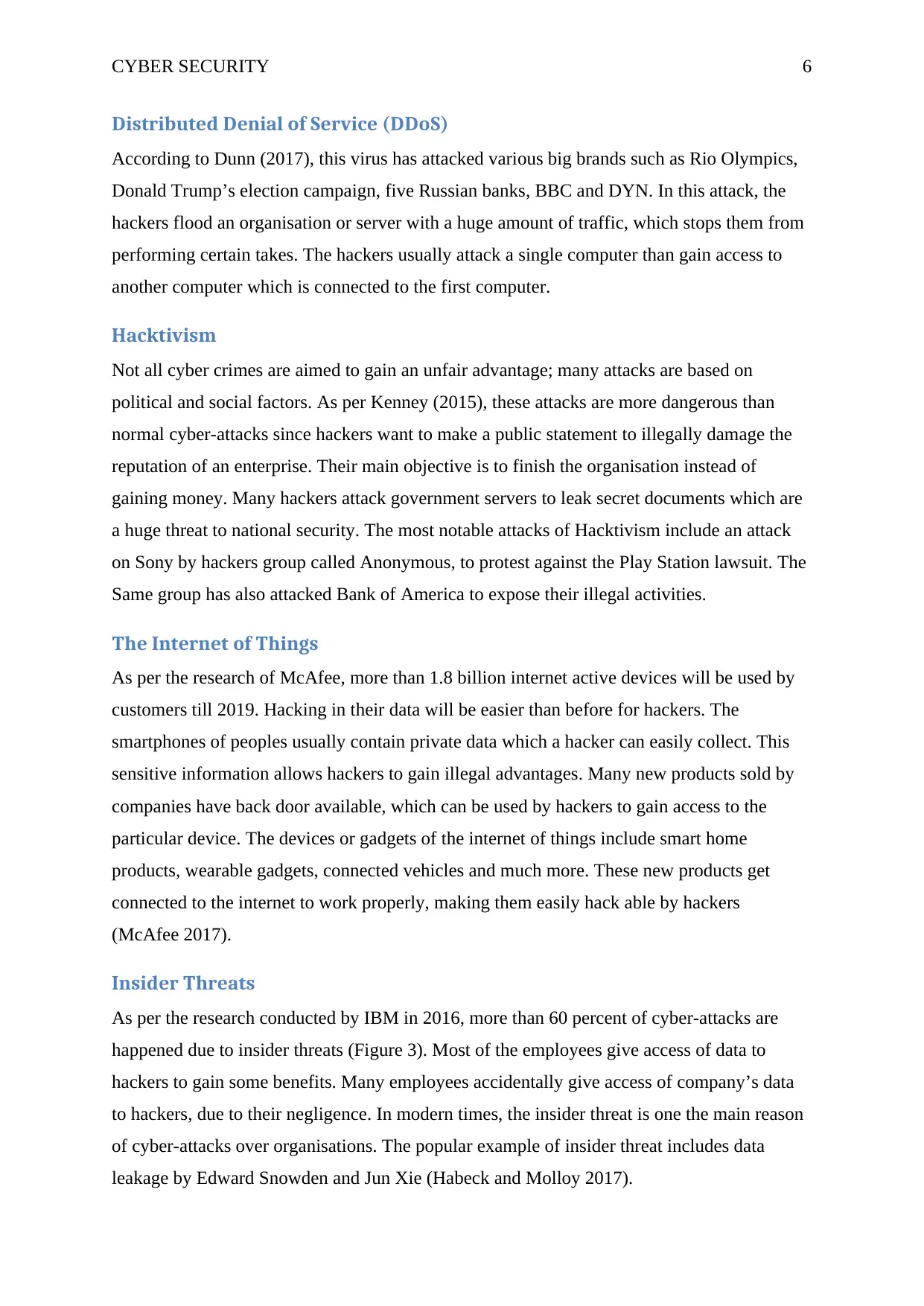
CYBER SECURITY 6
Distributed Denial of Service (DDoS)
According to Dunn (2017), this virus has attacked various big brands such as Rio Olympics,
Donald Trump’s election campaign, five Russian banks, BBC and DYN. In this attack, the
hackers flood an organisation or server with a huge amount of traffic, which stops them from
performing certain takes. The hackers usually attack a single computer than gain access to
another computer which is connected to the first computer.
Hacktivism
Not all cyber crimes are aimed to gain an unfair advantage; many attacks are based on
political and social factors. As per Kenney (2015), these attacks are more dangerous than
normal cyber-attacks since hackers want to make a public statement to illegally damage the
reputation of an enterprise. Their main objective is to finish the organisation instead of
gaining money. Many hackers attack government servers to leak secret documents which are
a huge threat to national security. The most notable attacks of Hacktivism include an attack
on Sony by hackers group called Anonymous, to protest against the Play Station lawsuit. The
Same group has also attacked Bank of America to expose their illegal activities.
The Internet of Things
As per the research of McAfee, more than 1.8 billion internet active devices will be used by
customers till 2019. Hacking in their data will be easier than before for hackers. The
smartphones of peoples usually contain private data which a hacker can easily collect. This
sensitive information allows hackers to gain illegal advantages. Many new products sold by
companies have back door available, which can be used by hackers to gain access to the
particular device. The devices or gadgets of the internet of things include smart home
products, wearable gadgets, connected vehicles and much more. These new products get
connected to the internet to work properly, making them easily hack able by hackers
(McAfee 2017).
Insider Threats
As per the research conducted by IBM in 2016, more than 60 percent of cyber-attacks are
happened due to insider threats (Figure 3). Most of the employees give access of data to
hackers to gain some benefits. Many employees accidentally give access of company’s data
to hackers, due to their negligence. In modern times, the insider threat is one the main reason
of cyber-attacks over organisations. The popular example of insider threat includes data
leakage by Edward Snowden and Jun Xie (Habeck and Molloy 2017).
Distributed Denial of Service (DDoS)
According to Dunn (2017), this virus has attacked various big brands such as Rio Olympics,
Donald Trump’s election campaign, five Russian banks, BBC and DYN. In this attack, the
hackers flood an organisation or server with a huge amount of traffic, which stops them from
performing certain takes. The hackers usually attack a single computer than gain access to
another computer which is connected to the first computer.
Hacktivism
Not all cyber crimes are aimed to gain an unfair advantage; many attacks are based on
political and social factors. As per Kenney (2015), these attacks are more dangerous than
normal cyber-attacks since hackers want to make a public statement to illegally damage the
reputation of an enterprise. Their main objective is to finish the organisation instead of
gaining money. Many hackers attack government servers to leak secret documents which are
a huge threat to national security. The most notable attacks of Hacktivism include an attack
on Sony by hackers group called Anonymous, to protest against the Play Station lawsuit. The
Same group has also attacked Bank of America to expose their illegal activities.
The Internet of Things
As per the research of McAfee, more than 1.8 billion internet active devices will be used by
customers till 2019. Hacking in their data will be easier than before for hackers. The
smartphones of peoples usually contain private data which a hacker can easily collect. This
sensitive information allows hackers to gain illegal advantages. Many new products sold by
companies have back door available, which can be used by hackers to gain access to the
particular device. The devices or gadgets of the internet of things include smart home
products, wearable gadgets, connected vehicles and much more. These new products get
connected to the internet to work properly, making them easily hack able by hackers
(McAfee 2017).
Insider Threats
As per the research conducted by IBM in 2016, more than 60 percent of cyber-attacks are
happened due to insider threats (Figure 3). Most of the employees give access of data to
hackers to gain some benefits. Many employees accidentally give access of company’s data
to hackers, due to their negligence. In modern times, the insider threat is one the main reason
of cyber-attacks over organisations. The popular example of insider threat includes data
leakage by Edward Snowden and Jun Xie (Habeck and Molloy 2017).
Paraphrase This Document
Need a fresh take? Get an instant paraphrase of this document with our AI Paraphraser
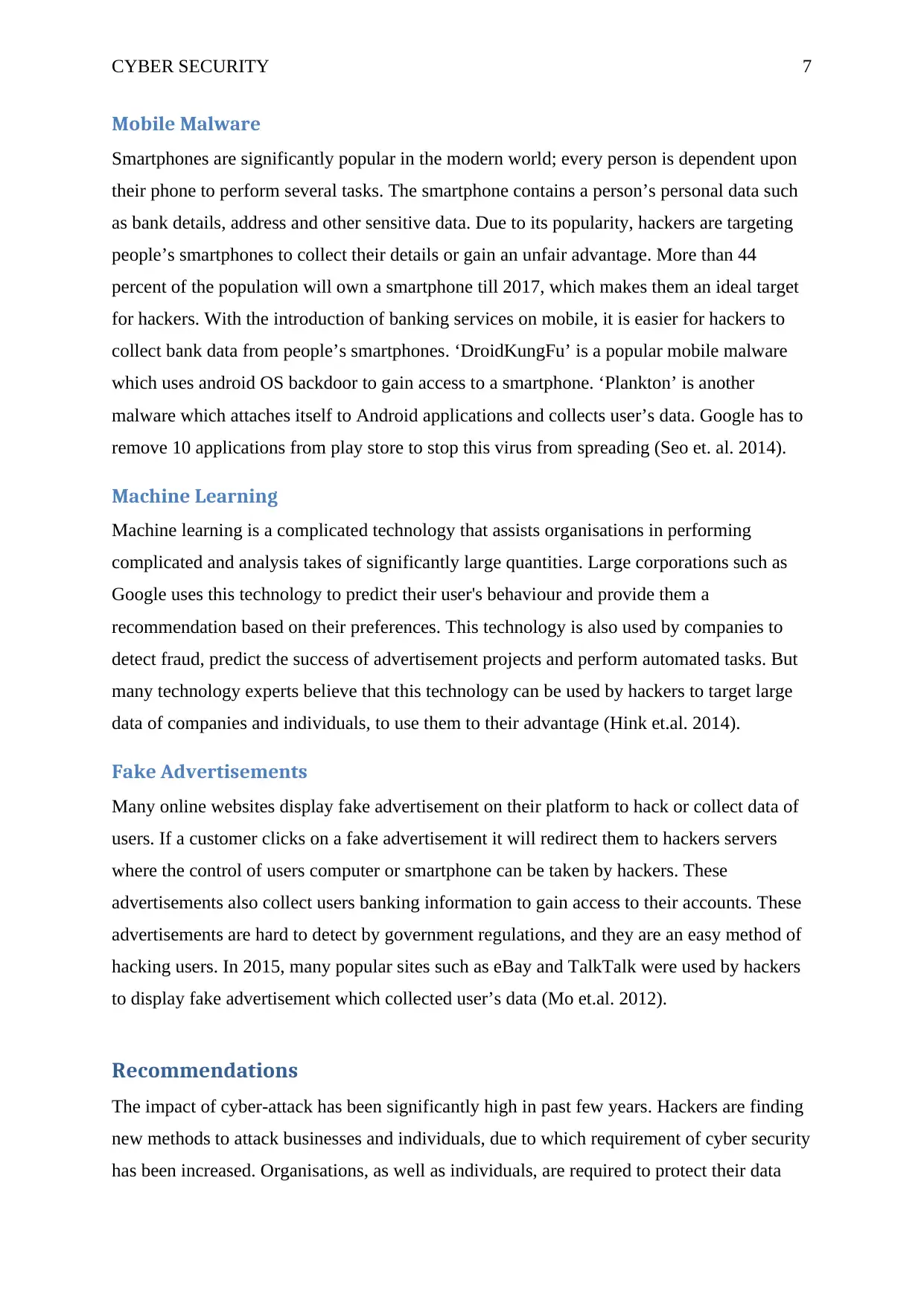
CYBER SECURITY 7
Mobile Malware
Smartphones are significantly popular in the modern world; every person is dependent upon
their phone to perform several tasks. The smartphone contains a person’s personal data such
as bank details, address and other sensitive data. Due to its popularity, hackers are targeting
people’s smartphones to collect their details or gain an unfair advantage. More than 44
percent of the population will own a smartphone till 2017, which makes them an ideal target
for hackers. With the introduction of banking services on mobile, it is easier for hackers to
collect bank data from people’s smartphones. ‘DroidKungFu’ is a popular mobile malware
which uses android OS backdoor to gain access to a smartphone. ‘Plankton’ is another
malware which attaches itself to Android applications and collects user’s data. Google has to
remove 10 applications from play store to stop this virus from spreading (Seo et. al. 2014).
Machine Learning
Machine learning is a complicated technology that assists organisations in performing
complicated and analysis takes of significantly large quantities. Large corporations such as
Google uses this technology to predict their user's behaviour and provide them a
recommendation based on their preferences. This technology is also used by companies to
detect fraud, predict the success of advertisement projects and perform automated tasks. But
many technology experts believe that this technology can be used by hackers to target large
data of companies and individuals, to use them to their advantage (Hink et.al. 2014).
Fake Advertisements
Many online websites display fake advertisement on their platform to hack or collect data of
users. If a customer clicks on a fake advertisement it will redirect them to hackers servers
where the control of users computer or smartphone can be taken by hackers. These
advertisements also collect users banking information to gain access to their accounts. These
advertisements are hard to detect by government regulations, and they are an easy method of
hacking users. In 2015, many popular sites such as eBay and TalkTalk were used by hackers
to display fake advertisement which collected user’s data (Mo et.al. 2012).
Recommendations
The impact of cyber-attack has been significantly high in past few years. Hackers are finding
new methods to attack businesses and individuals, due to which requirement of cyber security
has been increased. Organisations, as well as individuals, are required to protect their data
Mobile Malware
Smartphones are significantly popular in the modern world; every person is dependent upon
their phone to perform several tasks. The smartphone contains a person’s personal data such
as bank details, address and other sensitive data. Due to its popularity, hackers are targeting
people’s smartphones to collect their details or gain an unfair advantage. More than 44
percent of the population will own a smartphone till 2017, which makes them an ideal target
for hackers. With the introduction of banking services on mobile, it is easier for hackers to
collect bank data from people’s smartphones. ‘DroidKungFu’ is a popular mobile malware
which uses android OS backdoor to gain access to a smartphone. ‘Plankton’ is another
malware which attaches itself to Android applications and collects user’s data. Google has to
remove 10 applications from play store to stop this virus from spreading (Seo et. al. 2014).
Machine Learning
Machine learning is a complicated technology that assists organisations in performing
complicated and analysis takes of significantly large quantities. Large corporations such as
Google uses this technology to predict their user's behaviour and provide them a
recommendation based on their preferences. This technology is also used by companies to
detect fraud, predict the success of advertisement projects and perform automated tasks. But
many technology experts believe that this technology can be used by hackers to target large
data of companies and individuals, to use them to their advantage (Hink et.al. 2014).
Fake Advertisements
Many online websites display fake advertisement on their platform to hack or collect data of
users. If a customer clicks on a fake advertisement it will redirect them to hackers servers
where the control of users computer or smartphone can be taken by hackers. These
advertisements also collect users banking information to gain access to their accounts. These
advertisements are hard to detect by government regulations, and they are an easy method of
hacking users. In 2015, many popular sites such as eBay and TalkTalk were used by hackers
to display fake advertisement which collected user’s data (Mo et.al. 2012).
Recommendations
The impact of cyber-attack has been significantly high in past few years. Hackers are finding
new methods to attack businesses and individuals, due to which requirement of cyber security
has been increased. Organisations, as well as individuals, are required to protect their data

CYBER SECURITY 8
from hacker to avoid any misuse or illegal usage of data. Following are some
recommendations use by individuals and companies to protect their data from cyber-attacks:
Physically securing the computer hardware can assist companies to avoid cyber-
attacks. Checking of employees before entering or exiting, physically locking down
the units after work and avoid any third party access to a computer can help in
reducing the threat of cyber-attacks. Implementation of security guidelines for proper
physical security of cyber data and hardware components will avoid any physical
cyber threat (Agarwal 2017).
Companies are required to encrypt their data before transmitting them to various
servers. Generally, hackers look for data which is left behind and use such
information to attack a computer, but by encryption of data, the company can keep
information safe from hackers. The encryption of data and disk will only take few
extra minutes but it benefits the company a lot. Although for encryption to work
properly, the automatically log out of the user after 5 or 10 min feature shall also be
enabled, or unless the hackers will be able to physically gain access to employee’s
computer while they were on a break.
As per Lopez (2014), individual persons should change their passwords every week to
avoid any hacking and should only use strong passwords. They should also keep their
sensitive detail private such as bank details, passwords, security pins and other
information. Routinely checking of bank accounts and credit card details to determine
any unauthorised activity should also be helpful for early detection of hacking.
The organisation should embrace the safety guidelines as an integral part of their
corporate culture. Employees must be aware regarding the safety regulations, and they
know how to avoid any cyber threat. Providing proper training and also employing
proper IT employees should also benefit the company.
Creating a proper budget for safety expenditures is necessary for the safety of
information. Usually, companies avoid safety regulations due to their high cost but it
is necessary to avoid any future loss. The organisation should use antiviruses and
other security software’s to avoid any cyber-attack.
from hacker to avoid any misuse or illegal usage of data. Following are some
recommendations use by individuals and companies to protect their data from cyber-attacks:
Physically securing the computer hardware can assist companies to avoid cyber-
attacks. Checking of employees before entering or exiting, physically locking down
the units after work and avoid any third party access to a computer can help in
reducing the threat of cyber-attacks. Implementation of security guidelines for proper
physical security of cyber data and hardware components will avoid any physical
cyber threat (Agarwal 2017).
Companies are required to encrypt their data before transmitting them to various
servers. Generally, hackers look for data which is left behind and use such
information to attack a computer, but by encryption of data, the company can keep
information safe from hackers. The encryption of data and disk will only take few
extra minutes but it benefits the company a lot. Although for encryption to work
properly, the automatically log out of the user after 5 or 10 min feature shall also be
enabled, or unless the hackers will be able to physically gain access to employee’s
computer while they were on a break.
As per Lopez (2014), individual persons should change their passwords every week to
avoid any hacking and should only use strong passwords. They should also keep their
sensitive detail private such as bank details, passwords, security pins and other
information. Routinely checking of bank accounts and credit card details to determine
any unauthorised activity should also be helpful for early detection of hacking.
The organisation should embrace the safety guidelines as an integral part of their
corporate culture. Employees must be aware regarding the safety regulations, and they
know how to avoid any cyber threat. Providing proper training and also employing
proper IT employees should also benefit the company.
Creating a proper budget for safety expenditures is necessary for the safety of
information. Usually, companies avoid safety regulations due to their high cost but it
is necessary to avoid any future loss. The organisation should use antiviruses and
other security software’s to avoid any cyber-attack.
⊘ This is a preview!⊘
Do you want full access?
Subscribe today to unlock all pages.

Trusted by 1+ million students worldwide
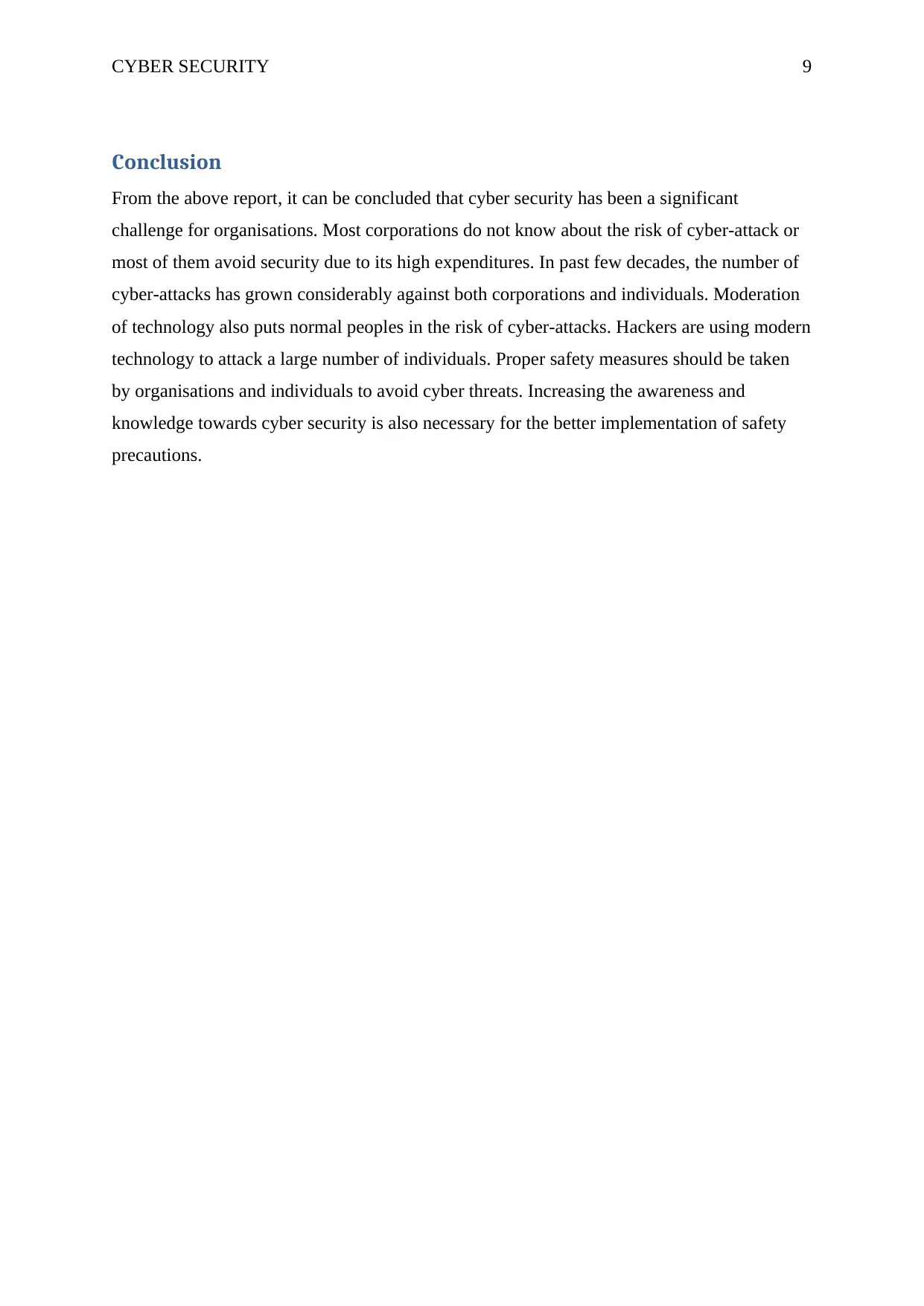
CYBER SECURITY 9
Conclusion
From the above report, it can be concluded that cyber security has been a significant
challenge for organisations. Most corporations do not know about the risk of cyber-attack or
most of them avoid security due to its high expenditures. In past few decades, the number of
cyber-attacks has grown considerably against both corporations and individuals. Moderation
of technology also puts normal peoples in the risk of cyber-attacks. Hackers are using modern
technology to attack a large number of individuals. Proper safety measures should be taken
by organisations and individuals to avoid cyber threats. Increasing the awareness and
knowledge towards cyber security is also necessary for the better implementation of safety
precautions.
Conclusion
From the above report, it can be concluded that cyber security has been a significant
challenge for organisations. Most corporations do not know about the risk of cyber-attack or
most of them avoid security due to its high expenditures. In past few decades, the number of
cyber-attacks has grown considerably against both corporations and individuals. Moderation
of technology also puts normal peoples in the risk of cyber-attacks. Hackers are using modern
technology to attack a large number of individuals. Proper safety measures should be taken
by organisations and individuals to avoid cyber threats. Increasing the awareness and
knowledge towards cyber security is also necessary for the better implementation of safety
precautions.
Paraphrase This Document
Need a fresh take? Get an instant paraphrase of this document with our AI Paraphraser
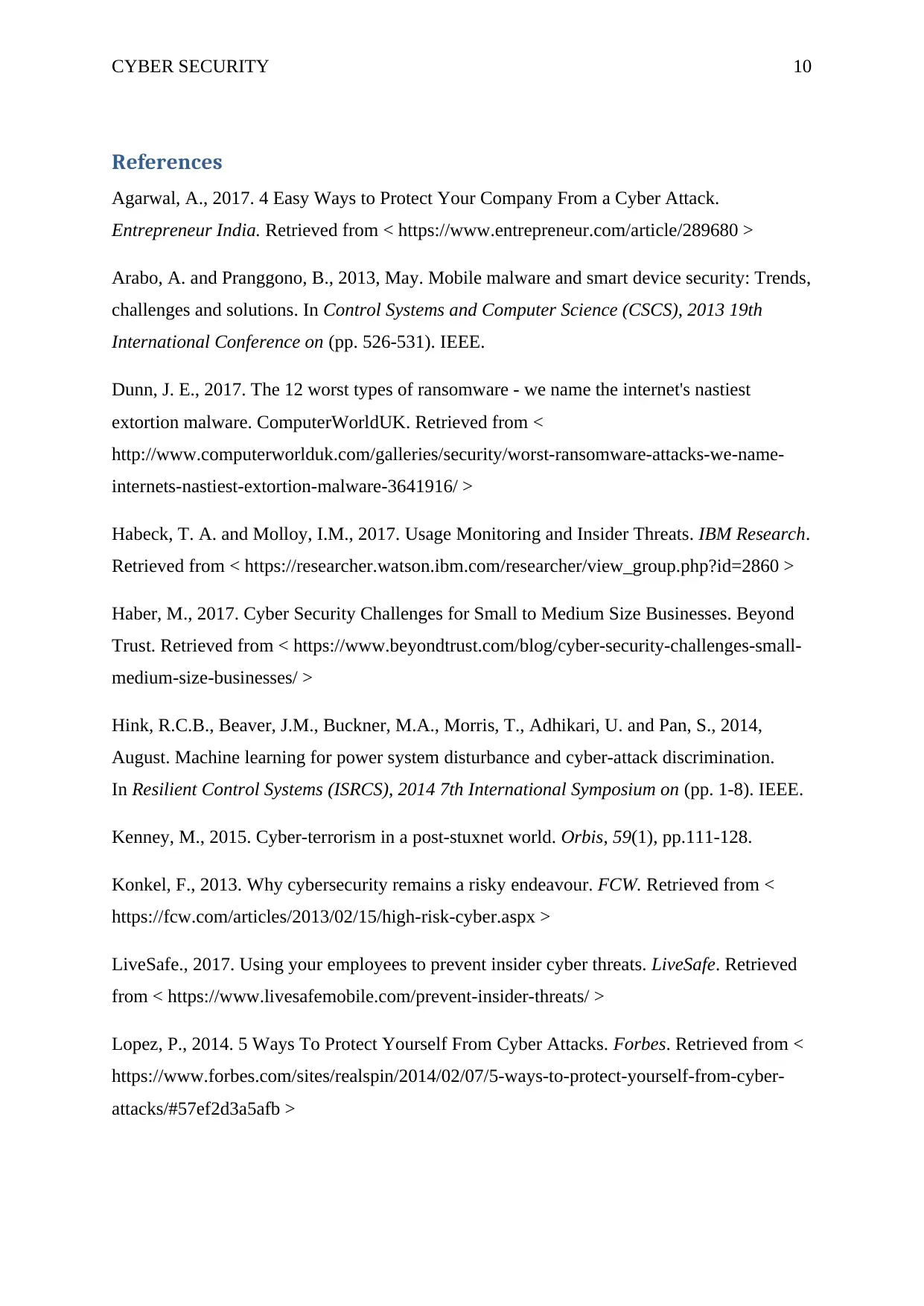
CYBER SECURITY 10
References
Agarwal, A., 2017. 4 Easy Ways to Protect Your Company From a Cyber Attack.
Entrepreneur India. Retrieved from < https://www.entrepreneur.com/article/289680 >
Arabo, A. and Pranggono, B., 2013, May. Mobile malware and smart device security: Trends,
challenges and solutions. In Control Systems and Computer Science (CSCS), 2013 19th
International Conference on (pp. 526-531). IEEE.
Dunn, J. E., 2017. The 12 worst types of ransomware - we name the internet's nastiest
extortion malware. ComputerWorldUK. Retrieved from <
http://www.computerworlduk.com/galleries/security/worst-ransomware-attacks-we-name-
internets-nastiest-extortion-malware-3641916/ >
Habeck, T. A. and Molloy, I.M., 2017. Usage Monitoring and Insider Threats. IBM Research.
Retrieved from < https://researcher.watson.ibm.com/researcher/view_group.php?id=2860 >
Haber, M., 2017. Cyber Security Challenges for Small to Medium Size Businesses. Beyond
Trust. Retrieved from < https://www.beyondtrust.com/blog/cyber-security-challenges-small-
medium-size-businesses/ >
Hink, R.C.B., Beaver, J.M., Buckner, M.A., Morris, T., Adhikari, U. and Pan, S., 2014,
August. Machine learning for power system disturbance and cyber-attack discrimination.
In Resilient Control Systems (ISRCS), 2014 7th International Symposium on (pp. 1-8). IEEE.
Kenney, M., 2015. Cyber-terrorism in a post-stuxnet world. Orbis, 59(1), pp.111-128.
Konkel, F., 2013. Why cybersecurity remains a risky endeavour. FCW. Retrieved from <
https://fcw.com/articles/2013/02/15/high-risk-cyber.aspx >
LiveSafe., 2017. Using your employees to prevent insider cyber threats. LiveSafe. Retrieved
from < https://www.livesafemobile.com/prevent-insider-threats/ >
Lopez, P., 2014. 5 Ways To Protect Yourself From Cyber Attacks. Forbes. Retrieved from <
https://www.forbes.com/sites/realspin/2014/02/07/5-ways-to-protect-yourself-from-cyber-
attacks/#57ef2d3a5afb >
References
Agarwal, A., 2017. 4 Easy Ways to Protect Your Company From a Cyber Attack.
Entrepreneur India. Retrieved from < https://www.entrepreneur.com/article/289680 >
Arabo, A. and Pranggono, B., 2013, May. Mobile malware and smart device security: Trends,
challenges and solutions. In Control Systems and Computer Science (CSCS), 2013 19th
International Conference on (pp. 526-531). IEEE.
Dunn, J. E., 2017. The 12 worst types of ransomware - we name the internet's nastiest
extortion malware. ComputerWorldUK. Retrieved from <
http://www.computerworlduk.com/galleries/security/worst-ransomware-attacks-we-name-
internets-nastiest-extortion-malware-3641916/ >
Habeck, T. A. and Molloy, I.M., 2017. Usage Monitoring and Insider Threats. IBM Research.
Retrieved from < https://researcher.watson.ibm.com/researcher/view_group.php?id=2860 >
Haber, M., 2017. Cyber Security Challenges for Small to Medium Size Businesses. Beyond
Trust. Retrieved from < https://www.beyondtrust.com/blog/cyber-security-challenges-small-
medium-size-businesses/ >
Hink, R.C.B., Beaver, J.M., Buckner, M.A., Morris, T., Adhikari, U. and Pan, S., 2014,
August. Machine learning for power system disturbance and cyber-attack discrimination.
In Resilient Control Systems (ISRCS), 2014 7th International Symposium on (pp. 1-8). IEEE.
Kenney, M., 2015. Cyber-terrorism in a post-stuxnet world. Orbis, 59(1), pp.111-128.
Konkel, F., 2013. Why cybersecurity remains a risky endeavour. FCW. Retrieved from <
https://fcw.com/articles/2013/02/15/high-risk-cyber.aspx >
LiveSafe., 2017. Using your employees to prevent insider cyber threats. LiveSafe. Retrieved
from < https://www.livesafemobile.com/prevent-insider-threats/ >
Lopez, P., 2014. 5 Ways To Protect Yourself From Cyber Attacks. Forbes. Retrieved from <
https://www.forbes.com/sites/realspin/2014/02/07/5-ways-to-protect-yourself-from-cyber-
attacks/#57ef2d3a5afb >
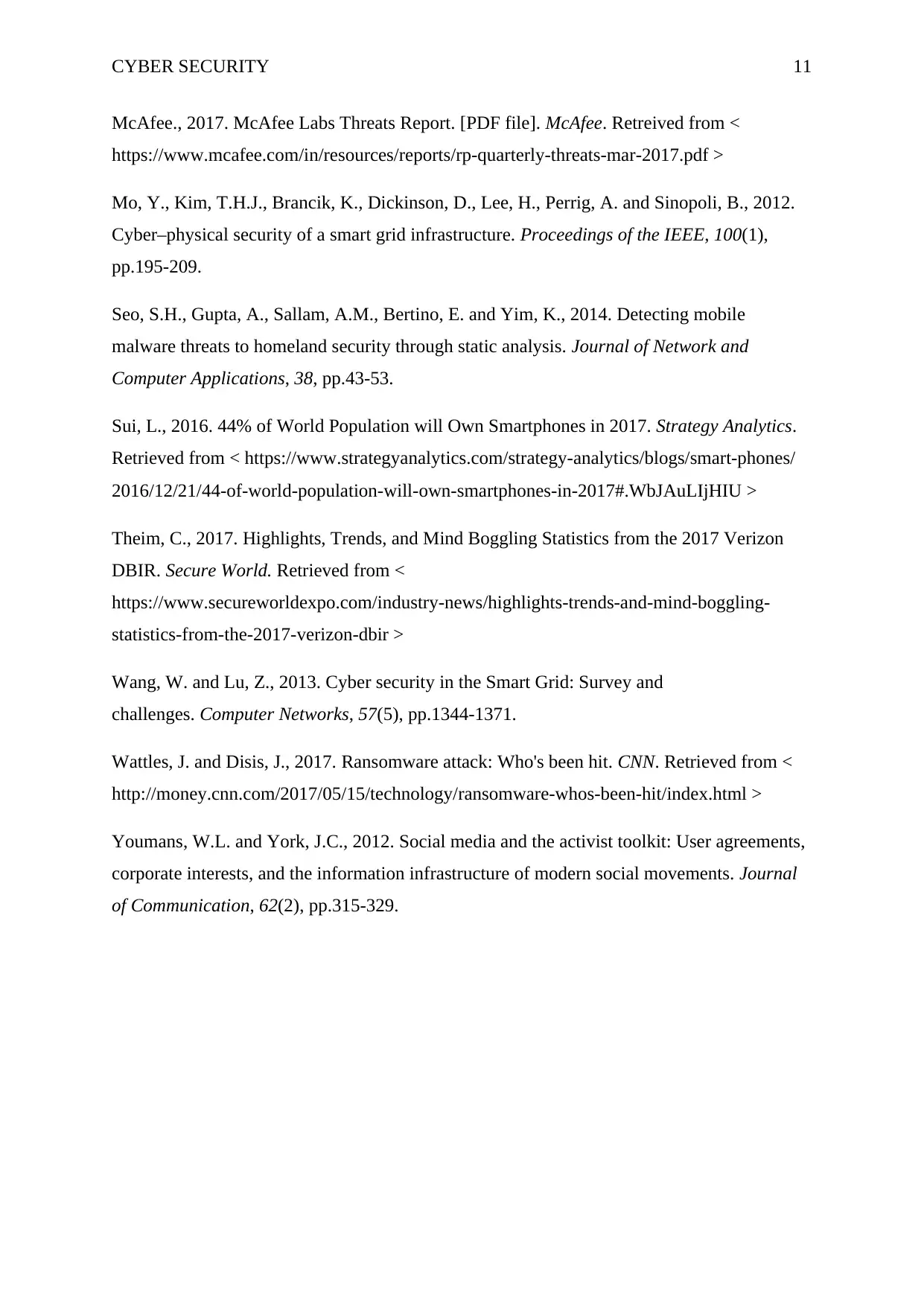
CYBER SECURITY 11
McAfee., 2017. McAfee Labs Threats Report. [PDF file]. McAfee. Retreived from <
https://www.mcafee.com/in/resources/reports/rp-quarterly-threats-mar-2017.pdf >
Mo, Y., Kim, T.H.J., Brancik, K., Dickinson, D., Lee, H., Perrig, A. and Sinopoli, B., 2012.
Cyber–physical security of a smart grid infrastructure. Proceedings of the IEEE, 100(1),
pp.195-209.
Seo, S.H., Gupta, A., Sallam, A.M., Bertino, E. and Yim, K., 2014. Detecting mobile
malware threats to homeland security through static analysis. Journal of Network and
Computer Applications, 38, pp.43-53.
Sui, L., 2016. 44% of World Population will Own Smartphones in 2017. Strategy Analytics.
Retrieved from < https://www.strategyanalytics.com/strategy-analytics/blogs/smart-phones/
2016/12/21/44-of-world-population-will-own-smartphones-in-2017#.WbJAuLIjHIU >
Theim, C., 2017. Highlights, Trends, and Mind Boggling Statistics from the 2017 Verizon
DBIR. Secure World. Retrieved from <
https://www.secureworldexpo.com/industry-news/highlights-trends-and-mind-boggling-
statistics-from-the-2017-verizon-dbir >
Wang, W. and Lu, Z., 2013. Cyber security in the Smart Grid: Survey and
challenges. Computer Networks, 57(5), pp.1344-1371.
Wattles, J. and Disis, J., 2017. Ransomware attack: Who's been hit. CNN. Retrieved from <
http://money.cnn.com/2017/05/15/technology/ransomware-whos-been-hit/index.html >
Youmans, W.L. and York, J.C., 2012. Social media and the activist toolkit: User agreements,
corporate interests, and the information infrastructure of modern social movements. Journal
of Communication, 62(2), pp.315-329.
McAfee., 2017. McAfee Labs Threats Report. [PDF file]. McAfee. Retreived from <
https://www.mcafee.com/in/resources/reports/rp-quarterly-threats-mar-2017.pdf >
Mo, Y., Kim, T.H.J., Brancik, K., Dickinson, D., Lee, H., Perrig, A. and Sinopoli, B., 2012.
Cyber–physical security of a smart grid infrastructure. Proceedings of the IEEE, 100(1),
pp.195-209.
Seo, S.H., Gupta, A., Sallam, A.M., Bertino, E. and Yim, K., 2014. Detecting mobile
malware threats to homeland security through static analysis. Journal of Network and
Computer Applications, 38, pp.43-53.
Sui, L., 2016. 44% of World Population will Own Smartphones in 2017. Strategy Analytics.
Retrieved from < https://www.strategyanalytics.com/strategy-analytics/blogs/smart-phones/
2016/12/21/44-of-world-population-will-own-smartphones-in-2017#.WbJAuLIjHIU >
Theim, C., 2017. Highlights, Trends, and Mind Boggling Statistics from the 2017 Verizon
DBIR. Secure World. Retrieved from <
https://www.secureworldexpo.com/industry-news/highlights-trends-and-mind-boggling-
statistics-from-the-2017-verizon-dbir >
Wang, W. and Lu, Z., 2013. Cyber security in the Smart Grid: Survey and
challenges. Computer Networks, 57(5), pp.1344-1371.
Wattles, J. and Disis, J., 2017. Ransomware attack: Who's been hit. CNN. Retrieved from <
http://money.cnn.com/2017/05/15/technology/ransomware-whos-been-hit/index.html >
Youmans, W.L. and York, J.C., 2012. Social media and the activist toolkit: User agreements,
corporate interests, and the information infrastructure of modern social movements. Journal
of Communication, 62(2), pp.315-329.
⊘ This is a preview!⊘
Do you want full access?
Subscribe today to unlock all pages.

Trusted by 1+ million students worldwide
1 out of 15
Related Documents
Your All-in-One AI-Powered Toolkit for Academic Success.
+13062052269
info@desklib.com
Available 24*7 on WhatsApp / Email
![[object Object]](/_next/static/media/star-bottom.7253800d.svg)
Unlock your academic potential
Copyright © 2020–2025 A2Z Services. All Rights Reserved. Developed and managed by ZUCOL.





